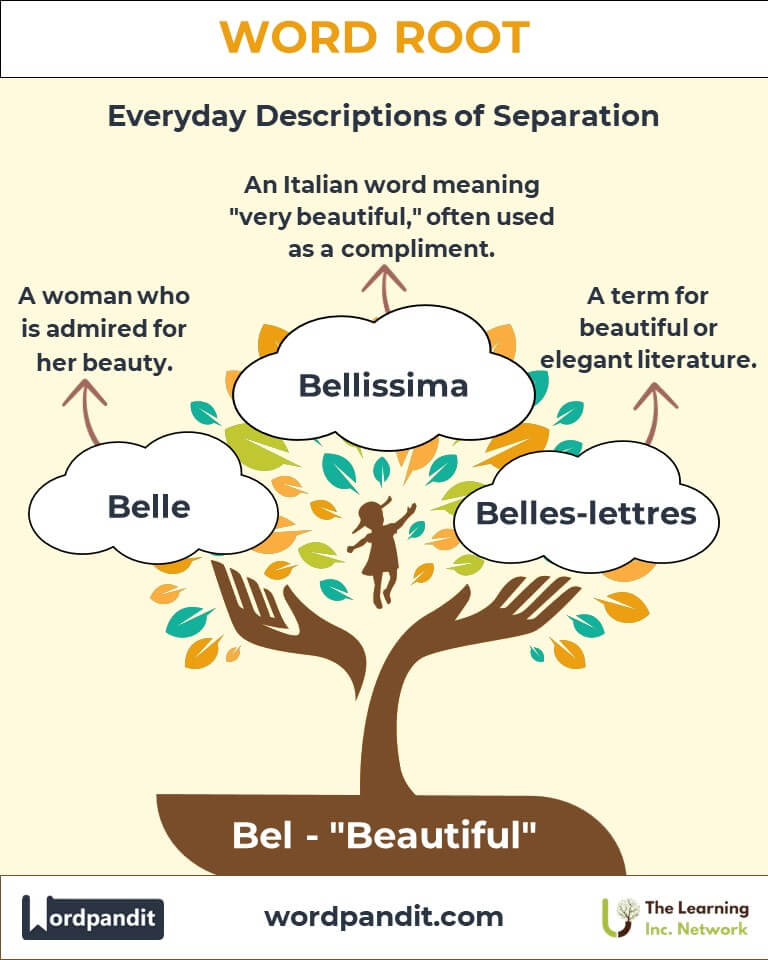Bel: The Root of Beauty and War in Language and Culture
Explore the intricate layers of the word root "Bel," meaning "beautiful" or "war," originating from Latin and Old French. This versatile root reveals fascinating intersections between aesthetics and conflict across history, language, and specialized fields.

Table of Contents
- Introduction: The Duality of Bel
- Etymology and Historical Journey
- Mnemonic: Unlocking the Power of Bel
- Common Bel-Related Terms
- Bel Through Time
- Bel in Specialized Fields
- Illustrative Story: Bel in Action
- Cultural Significance of the Bel Root
- The Bel Family Tree
- FAQs About the Bel Word Root
- Test Your Knowledge: Bel Mastery Quiz
- Conclusion: The Living Legacy of Bel
1. Introduction: The Duality of Bel
Can beauty and conflict coexist in a single word? The root Bel (pronounced "bel") captures this paradox perfectly. Stemming from Latin bellus ("beautiful") and bellum ("war"), Bel spans a spectrum of meanings, linking the allure of beauty to the harsh realities of war. This dichotomy reflects humanity's capacity for both creation and destruction, encapsulating the root's timeless relevance in language, art, and human history.

2. Etymology and Historical Journey
The root Bel has dual origins:
- Beauty: Latin bellus referred to "beautiful" or "handsome," evolving into Old French bel and modern English terms celebrating aesthetic appeal.
- War: From the Latin bellum, meaning "war," the root expanded into terms like "belligerent" and "rebellion," denoting conflict and strife.
Both streams demonstrate how Bel has been used to capture the grandeur of both peace and turmoil.
3. Mnemonic: Unlocking the Power of Bel
To remember Bel's dual nature, picture a serene battlefield after a storm, where the sun illuminates both beauty and remnants of conflict.
Mnemonic Device: "Bel is where beauty and battle meet—splendid in peace, fierce in strife."
4. Common Bel-Related Terms
- Belle: A beautiful woman.
Example: "The belle of the ball captivated everyone with her grace." - Belligerent: Aggressive or warlike behavior.
Example: "The belligerent nations signed a fragile ceasefire." - Rebellion: Resistance against authority.
Example: "The rebellion was fueled by a desire for freedom." - Embellish: To make something more attractive by adding details.
Example: "She embellished her story to make it more compelling." - Bellicose: Demonstrating aggression or a willingness to fight.
Example: "The bellicose leader pushed his nation into conflict."
5. Bel Through Time
- Bellona: In Roman mythology, Bellona was the goddess of war. Her name embodies the root Bel, tying beauty to the martial virtues admired by Romans.
- Belle Époque: A period of peace and artistic flourishing in late 19th-century Europe, translating to "Beautiful Era."
Legacy: It symbolizes a golden age, contrasting with the devastation of World War I.
6. Bel in Specialized Fields
- Art and Design: Embellish is a cornerstone of decorative arts, emphasizing the root's connection to aesthetic enhancement.
- Psychology: Words like belligerent describe aggressive tendencies, reflecting how conflict arises from emotional states.
- History and Politics: Rebellion is central to studies of revolutions, highlighting the tension between authority and resistance.
- Linguistics: Bel illustrates how roots can carry conflicting meanings, enriching the study of etymology and semantics.
7. Illustrative Story: Bel in Action
In a bustling museum, Dr. Anabelle Carter, an art historian, is tasked with authenticating a newly discovered Renaissance painting. Amid the brushstrokes of delicate embellishments lies an inscription in Latin: Bellum et Pax. Using her linguistic expertise, she interprets the phrase as "War and Peace," uncovering the painting’s hidden message about the artist’s views on societal harmony.
8. Cultural Significance of the Bel Root
The root Bel has inspired cultural expressions worldwide:
- Roman Mythology: Bellona symbolizes the valor and aesthetic of war.
- French Influence: Belle became synonymous with elegance, as seen in terms like Belle Époque.
- Global Movements: Words like rebellion have been rallying cries in social and political movements, emphasizing the fight for beauty and justice.

9. The Bel Family Tree
- Bene (Latin for "good"):
- Benefit: An advantage or positive outcome.
- Benevolent: Well-meaning and kind.
- Bellum (Latin for "war"):
- Antebellum: Before the war.
- Postbellum: After the war.
FAQs About the "Bel" Word Root
1. What are the primary meanings of the root Bel?
The root Bel primarily means "beautiful" or "war." These dual meanings stem from different Latin origins—bellus for beauty and bellum for war. This dichotomy highlights the root’s versatility in expressing both harmony and conflict.
2. How did Bel come to represent both beauty and war?
The root Bel has separate linguistic pathways. Bellus was used in Latin to mean "beautiful" or "charming," while bellum meant "war." Over time, both meanings coexisted and developed into words reflecting aesthetics and aggression.
3. What does belligerent literally mean?
Belligerent combines bellum (war) and gerere (to carry), meaning "engaged in war" or "hostile." It is often used figuratively to describe a combative attitude in modern contexts.
4. What does the phrase Belle Époque signify?
Belle Époque, meaning "Beautiful Era," refers to a time of cultural and artistic flourishing in Europe during the late 19th and early 20th centuries. It was marked by peace, innovation, and elegance, preceding World War I.
5. How is rebellion related to Bel?
Rebellion comes from re- (again) and bellum (war), literally meaning "to wage war again." It encapsulates resistance or defiance, often against authority.
Test Your Knowledge: Bel Mastery Quiz
1. What does Bel mean?
2. Which term means "aggressive"?
3. What era does Belle Époque refer to?
4. What does rebellion literally mean?
5. Which goddess is associated with Bel?
12. Conclusion: The Living Legacy of Bel
The word root Bel is a testament to the complexity of human expression, intertwining themes of beauty and conflict. From ancient myths to modern disciplines, its duality enriches our understanding of art, psychology, and history. As language evolves, Bel will continue to illuminate the balance between harmony and discord, urging us to appreciate both the beautiful and the tumultuous aspects of existence.












